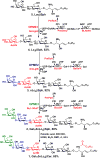Highly efficient chemoenzymatic synthesis and facile purification of α-Gal pentasaccharyl ceramide Galα3nLc4βCer
- PMID: 28695219
- PMCID: PMC5597046
- DOI: 10.1039/c7cc04090c
Highly efficient chemoenzymatic synthesis and facile purification of α-Gal pentasaccharyl ceramide Galα3nLc4βCer
Abstract
A highly efficient chemoenzymatic method for synthesizing glycosphingolipids using α-Gal pentasaccharyl ceramide as an example is reported here. Enzymatic extension of the chemically synthesized lactosyl sphingosine using efficient sequential one-pot multienzyme (OPME) reactions allowed glycosylation to be carried out in aqueous solutions. Facile C18 cartridge-based quick (<30 minutes) purification protocols were established using minimal amounts of green solvents (CH3CN and H2O). Simple acylation in the last step led to the formation of the target glycosyl ceramide in 4 steps with an overall yield of 57%.
Figures




Similar articles
-
Enabling Chemoenzymatic Strategies and Enzymes for Synthesizing Sialyl Glycans and Sialyl Glycoconjugates.Acc Chem Res. 2024 Jan 16;57(2):234-246. doi: 10.1021/acs.accounts.3c00614. Epub 2023 Dec 21. Acc Chem Res. 2024. PMID: 38127793 Free PMC article.
-
Streamlined chemoenzymatic total synthesis of prioritized ganglioside cancer antigens.Org Biomol Chem. 2018 Jun 6;16(22):4076-4080. doi: 10.1039/c8ob01087k. Org Biomol Chem. 2018. PMID: 29789847 Free PMC article.
-
Chemoenzymatic Synthesis and Facile Purification of Gangliosides.Curr Protoc. 2021 Mar;1(3):e91. doi: 10.1002/cpz1.91. Curr Protoc. 2021. PMID: 33760402 Free PMC article.
-
Recent progress in the synthesis of glycosphingolipids.Curr Opin Chem Biol. 2024 Feb;78:102423. doi: 10.1016/j.cbpa.2023.102423. Epub 2024 Jan 6. Curr Opin Chem Biol. 2024. PMID: 38184907 Review.
-
Recent advances in the glycosylation of sphingosines and ceramides.Carbohydr Res. 2007 Sep 3;342(12-13):1595-612. doi: 10.1016/j.carres.2007.03.028. Epub 2007 Apr 11. Carbohydr Res. 2007. PMID: 17482586 Review.
Cited by
-
Oligosaccharide Synthesis and Translational Innovation.J Am Chem Soc. 2019 Mar 6;141(9):3735-3754. doi: 10.1021/jacs.8b11005. Epub 2019 Feb 18. J Am Chem Soc. 2019. PMID: 30716271 Free PMC article. Review.
-
Process Engineering and Glycosyltransferase Improvement for Short Route Chemoenzymatic Total Synthesis of GM1 Gangliosides.Chemistry. 2023 May 2;29(25):e202300005. doi: 10.1002/chem.202300005. Epub 2023 Mar 17. Chemistry. 2023. PMID: 36596720 Free PMC article.
-
Synthetic Carbohydrate Chemistry and Translational Medicine.J Org Chem. 2020 Dec 18;85(24):15780-15800. doi: 10.1021/acs.joc.0c01834. Epub 2020 Oct 30. J Org Chem. 2020. PMID: 33125238 Free PMC article.
-
Chemoenzymatic Total Synthesis of GM3 Gangliosides Containing Different Sialic Acid Forms and Various Fatty Acyl Chains.J Org Chem. 2021 Jul 2;86(13):8672-8682. doi: 10.1021/acs.joc.1c00450. Epub 2021 Jun 21. J Org Chem. 2021. PMID: 34152144 Free PMC article.
-
Potassium carbonate-mediated β-selective anomeric O-alkylation with primary electrophiles: Application to the synthesis of glycosphingolipids.Tetrahedron Lett. 2023 Jun 6;122:154511. doi: 10.1016/j.tetlet.2023.154511. Epub 2023 Apr 19. Tetrahedron Lett. 2023. PMID: 37334260 Free PMC article.
References
Grants and funding
LinkOut - more resources
Full Text Sources
Other Literature Sources

